Turning Self-awareness into Action: Put the MBTI® Framework in Your Pocket
John Hackston, Head of Thought Leadership, The Myers-Briggs Company
Many people find that discovering their personality type through receiving MBTI® feedback can be life-changing – but not everyone does. Why is that?
When someone starts to use what they learn from the MBTI feedback process in their everyday life, it can be incredibly effective. If, instead, ‘feedback’ means that they just take away ‘the four letters’ and the process stops there, it is probably a waste of time and energy. When an individual completes the MBTI assessment, has feedback, but then does nothing else, any learning evaporates, and the value of the process is lost. These are the people who six months later you’ll hear say, “I was an E… and was it F?”.
In a development context, the goal of using personality questionnaires is typically to increase an individual’s self-awareness and understanding of themselves and others, and to give them the tools to apply this knowledge. The MBTI process can be very effective here – we know this from research – but only if people use the knowledge that they can gain from feedback. The challenge is to make the learning stick, to achieve what has been called experiential validity.
This isn’t a small problem, or one restricted to personality questionnaires. Facilitating real change is the goal of many development interventions but can be very hard to achieve. Fortunately, there are already a number of ways to help people remember and use their MBTI type, such as the website linked to Introduction to Myers-Briggs Type or the Flip a Type Tip. But, in today’s world of information at your fingertips, we’re now one step further. The new Myers-Briggs App provides information on demand to help facilitate positive behaviour change from self-awareness and awareness of others. The app helps people keep their knowledge of the MBTI framework alive, and is a handy go-to reminder of their likely strengths, blind spots, work style and approach to stress. It also shows how they can work together more effectively with colleagues who have different personality type preferences.
When you first start up the app you’ll be asked for your best-fit type, but you can also browse the interactive table for bite-sized summaries of all 16 MBTI types. My type preferences are for INTP, as you can see from the examples below. Going further you can explore any type in detail, looking at the typical strengths, work behaviours, reaction to stress and likely blind spots. And, of course, you can drill into each of these in more detail: under ‘at work’ there’s detailed practical information on leadership style, approach to solving problems, and preferred working environment.
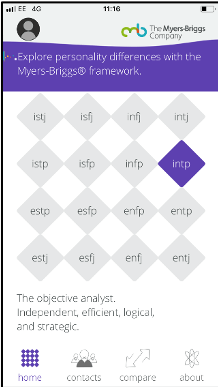
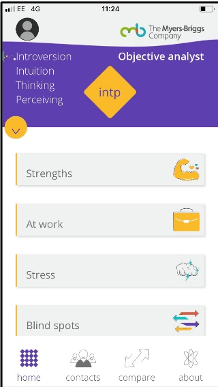
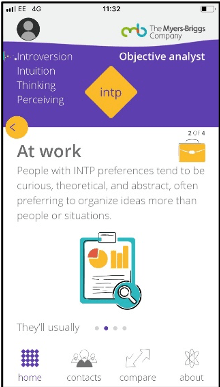
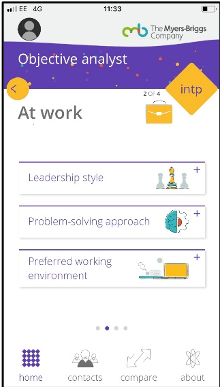
Many people find the MBTI framework especially useful in helping them to understand other people’s behaviour. The Myers-Briggs App lets you import your contacts and add their four-letter MBTI type, so you can easily compare their type with yours. You can explore your relative strengths and blind spots, what each of you like, and, crucially, how you can work together – what each of you want, and what each of you tend to give. I’ve already started using the app for this, and I have to say that it has been very useful. But perhaps I’d better not go into details in this public forum…
It’s like having a type coach on standby every time you are about to have an important or challenging conversation. And, of course, you can use this feature to compare any two MBTI types, to look at the relationship between two members of your team for example. From its very beginnings, the MBTI assessment has been used to help people understand not only themselves, but also each other. The Myers-Briggs App is the next iteration of that process.
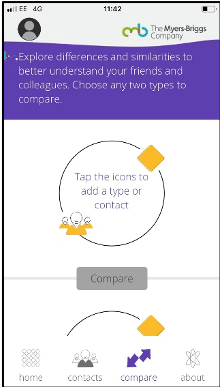
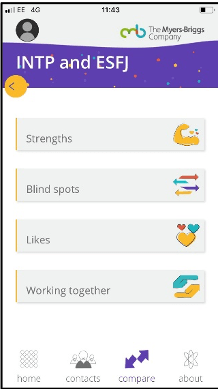
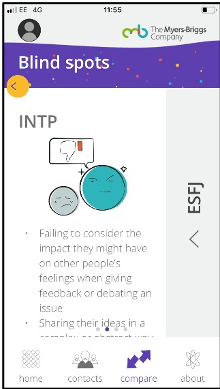
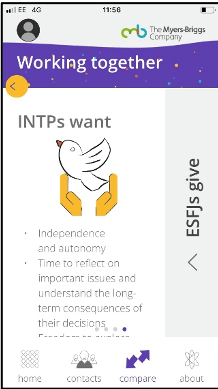
MBTI practitioners can download the app by following instructions at the bottom of this page. We see this as the first stage of putting personality insights into your pocket, and we will be adding further content and personalisation in the future. There is a great deal of research from other areas – fitness apps for example – that with the right features, people can achieve the changes they want. But we want these new features to fit your needs. What would you like the app to do? Let us know, and we’ll see if we can make it happen.